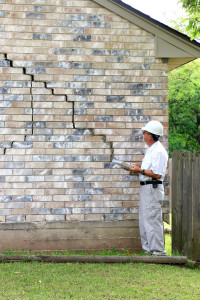 Few situations strike fear into the hearts of homeowners quite like “foundation damage.”
Few situations strike fear into the hearts of homeowners quite like “foundation damage.”
That’s because, not only are potential structural problems a costly proposition, the simple fact that your home’s structural integrity may be compromised makes it a safety issue as well. While rare, residential buildings have been known to collapse, and the risks of injury, or even death, in such an incident are very real.
For example, in February 2016 a wall collapse at a Washington, D.C. rowhouse forced five residents from their homes and kicked off a lengthy repair process that is still ongoing. It is believed that nearby construction work, along with the heavy rain that fell in the area in the days leading up to the incident, contributed to the collapse.
“I noticed a huge crack in my bedroom and it went all the way down into my window,” one of the residents told the local Fox TV station at the time. “When I went over to investigate more closely, I heard a noise and it freaked me out. So when I called the landlord, it sort of escalated from there. I couldn’t explain it to you, but it put enough fear in me that I wanted to get out of the house as soon as possible.”
Diagnosing the problem
And that’s just the beginning. Once the immediate threat from a structural problem has been resolved, repairing a damaged foundation can easily turn into a five-figure project.
In fact, according to a study of more than 1,300 cost profiles by home repair site HomeAdvisor.com, the average cost of a foundation repair is more than $4,000, with jobs reaching $10,000 and well beyond, depending on the scope and severity of the damage, as well as the location of the home.
That’s why it is critically important for homeowners to know the signs of structural damage, and to know what action to take in the event of a serious problem.
A home’s foundation is, literally, the bedrock that the rest of the structure is built on top of. That’s why structural problems with the foundation will typically show up in other parts of the home.
- Indoors: Inside the home, hat show up in walls and floors and grow over time, especially over doorways or where the walls meet the ceiling. Also keep an eye out for doors that begin to jam or fail to latch, as well as windows that start to stick or won’t close completely. What’s happening is the structure of the house around these doors and windows is shifting, altering their alignment within the frame.
- Basement: In the basement, a sure sign of foundation damage is cracking in the foundation itself or bulging in concrete or masonry walls. Related signs include walls that are out of alignment, floors that are not level, as well as signs of separation between the foundation walls and the structure above.
- Outside: Structural damage to a house is often easy to spot from the outside, in the form of stair-step cracks running along the exterior brick, gaps around doors or windows, and things like chimneys that appear to be pulling away from the rest of the structure.
- The home inspection process
Remember, just because you’ve ordered a standard home inspection doesn’t mean you’re getting a review of the structural features of your home. Under Colorado law, only a licensed, professional engineer is qualified to provide a structural diagnosis, in part due to the rigorous testing and experience that go into obtaining the Professional Engineer license, so if you have any concerns about your foundation a typical home inspector will usually have to refer you to an engineer for assessment.
Here at Home Inspection Engineers, our engineers have a solid understanding of workmanship, materials, and proper completion of items both inside and out of the home, and are fully qualified to assess the structure and foundation of the homes we inspect. That’s why we consult on a variety of structural issues and concerns, working with prospective buyers, current home owners, property sellers, and financial institutions to ensure that all of the structures we inspect are safe, structurally sound, and ready for a long, trouble-free life.
